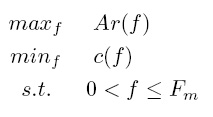|
Researchers: Hong Li, Ph.D. student & Prof. Lorne Mason
Description:
Problem: The motivation for this study is the application of monitoring in QoS routing for VoIP in SONs. We sent UDP
packets periodically to the SON to measure the network delay.
The monitoring process will add additional overhead on the
network. The goal of the project is to minimize the cost of monitoring and
also minimize the estimation error of the network delay.
Approach: we
solve a bi-objective optimization problem to find the fair
compromise between the conflicting objectives of sampling
cost minimization and sampling accuracy maximization.
The problem of maximizing the sampling accuracy Ar(f)
while minimizing the sampling cost c(f) can be formulated
as a bi-objective optimization problem:
.
 or or 
Fig: Biobjective optimization problem.
Then we get the following results. The optimal solution to the bi-objective optimization
problem is a Pareto efficient solution; and
the proportional fair optimal solution to the
bi-objective optimization problem maximizes the product
of the two objectives in the right of the above problem formulation.
Simulation Results:
We generated a stationary network delay trace x(n) with
fBm traffic, as shown in the top following figure. The
parameters of the fBm traffic from Bellcore data OctExtTL
are as follows: Hurst parameter H=0.86, mean input rate
m=12.3kbit/sec, and variance coefficient a=68.6kbitĚ sec .
We fit the generated network delay to various distributions
and find that shifted Gamma distribution gives the best fit
compared to other distributions. Then we apply the optimal
sampling method to sample the generated network
delay trace with fBm traffic, as shown in the top of the following figure.

Fig: Original Network delay (top) V.S. Sampled netework delay (bottom left) V.S. Reconstructed network delay(bottom right)
Publications:
H. Li and L. Mason, "Estimation and Simulation of Network Delay Traces for VoIP in Service Overlay Network", in Proc. IEEE ISSSE, July/Aug. 2007, Montreal, QC, Canada. [pdf]
|



